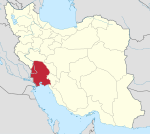Kul-e Farah
Kul-e Farah (or "Kul-e Fara") is the site of six Elamite rock reliefs that are located in a gorge on the plain's east side. Kul-e Farah is located near the city of Izeh in Khuzestan, southwest Iran. The reliefs were first visited in European research by Austen Henry Layard in 1841. Layard copied the 24-line cuneiform inscription on relief I, and five of the short epigraphs on some of the figures.[1]
It has been suggested that this is a kind of open sanctuary for religious ceremonies involving the sacrifice of animals. Three are on rock faces, while the other three are on large boulders. They depict scenes of sacrifice, processions and a banquet, and three show groups of musicians. The inscription on relief I mentions Hanni, the son of Tahhi, and is therefore dated to Hanni's time (7th century BCE?). But the reliefs may belong to several periods, with reliefs III, IV, and VI dated to the end of the 2nd or the beginning of the 1st millennium BCE.[1]
Contents
1 Gallery
2 Reliefs
2.1 Kul-e Farah I (Offering Scene of Hanni)
2.2 Kul-e Farah II (Offering Scene)
2.3 Kul-e Farah III (Offering Scene)
2.4 Kul-e Farah IV (Procession)
2.5 Kul-e Farah V (Offering Scene)
2.6 Kul-e Farah VI (Adoration Scene)
3 See also
4 References
5 Further reading
6 External links
Gallery

Kul-e Farah I
Kul-e Farah II
Kul-e Farah III
Kul-e Farah IV

Kul-e Farah V
Kul-e Farah VI
Kul-e farah IV (other view)
Reliefs
Kul-e Farah I (Offering Scene of Hanni)
Kul-e Farah Neo-Elamite rock relief is cut in the rock and is about 1.10 - 1,30 m high and about 1.66 m wide. The field is dominated by a person named Hanni, who looks to the right. Behind her stand two officials. It is the first minister of the army and vizier Schutruru Schutrurura, both of which are identified by incised inscriptions. The right side of the field is divided into two registers. At the top you will find musicians in the lower sacrificial scenes. The upper part of the field is covered with a long inscription of 24 lines, which is partly about the characters. The text begins with an invocation of Elamite gods including Shilhite, who the reliefs were made for. That is then followed by the authors introduction of himself as hanni son of tahhi. The next passages are unclear but contain a reference to king Shutur-Nahhunte, son of indada. The text is then concluded with a request that the inscription be given divine protection and a curse to any who dare damage it.[2]
Kul-e Farah II (Offering Scene)
Kul-e Farah II represents a single person probably a ruler or priest, standing and looking right side. Behind him are four little people, cattle are slaughtered before him. The whole scene is probably showing a victim. There will be no explanatory inscriptions.
Kul-e Farah III (Offering Scene)
Kul-e Farah III is located on a detached rock, which bears a relief decoration on all sides. The south side measuring about 4.9 x 3 meters. Right turn is a major figure, perhaps a king. Behind and in front of him are found in four rows of numerous small figures that look all right. On the north side there is a similar view, only that now all people look to the left, then to the east. On the east side one finds the representation of cattle. On the west side turn people into four tabs, which look to the right.
Kul-e Farah IV (Procession)
Kul-e Farah IV is not well preserved. It is again a rock, which is decorated on several pages. On one side we see a number of people who look to the right or turn to march. On another page you can see five tabs. Above sits a king or priest, while several persons including his turn.
Kul-e Farah V (Offering Scene)
Kul-e Farah V represents a single person, which is again turned to the right and apparently sacrificed.
Kul-e Farah VI (Adoration Scene)
Kul-e Farah VI shows a large left facing person who is surrounded by smaller figures.
See also
- Eshkaft-e Salman
References
^ ab Curtis, John. "LAYARD, Austen Henry". Encyclopedia Iranica. Retrieved 2011-07-09..mw-parser-output cite.citation{font-style:inherit}.mw-parser-output .citation q{quotes:"""""""'""'"}.mw-parser-output .citation .cs1-lock-free a{background:url("//upload.wikimedia.org/wikipedia/commons/thumb/6/65/Lock-green.svg/9px-Lock-green.svg.png")no-repeat;background-position:right .1em center}.mw-parser-output .citation .cs1-lock-limited a,.mw-parser-output .citation .cs1-lock-registration a{background:url("//upload.wikimedia.org/wikipedia/commons/thumb/d/d6/Lock-gray-alt-2.svg/9px-Lock-gray-alt-2.svg.png")no-repeat;background-position:right .1em center}.mw-parser-output .citation .cs1-lock-subscription a{background:url("//upload.wikimedia.org/wikipedia/commons/thumb/a/aa/Lock-red-alt-2.svg/9px-Lock-red-alt-2.svg.png")no-repeat;background-position:right .1em center}.mw-parser-output .cs1-subscription,.mw-parser-output .cs1-registration{color:#555}.mw-parser-output .cs1-subscription span,.mw-parser-output .cs1-registration span{border-bottom:1px dotted;cursor:help}.mw-parser-output .cs1-ws-icon a{background:url("//upload.wikimedia.org/wikipedia/commons/thumb/4/4c/Wikisource-logo.svg/12px-Wikisource-logo.svg.png")no-repeat;background-position:right .1em center}.mw-parser-output code.cs1-code{color:inherit;background:inherit;border:inherit;padding:inherit}.mw-parser-output .cs1-hidden-error{display:none;font-size:100%}.mw-parser-output .cs1-visible-error{font-size:100%}.mw-parser-output .cs1-maint{display:none;color:#33aa33;margin-left:0.3em}.mw-parser-output .cs1-subscription,.mw-parser-output .cs1-registration,.mw-parser-output .cs1-format{font-size:95%}.mw-parser-output .cs1-kern-left,.mw-parser-output .cs1-kern-wl-left{padding-left:0.2em}.mw-parser-output .cs1-kern-right,.mw-parser-output .cs1-kern-wl-right{padding-right:0.2em}
^ https://books.google.ca/books?id=mc4cfzkRVj4C&pg=PA303&lpg=PA303&dq=Kul-e+Farah+elamite+text&source=bl&ots=iyn8E_XVzH&sig=4Y0XAGUDm2Hh-8AaOOuXxVOAlhw&hl=en&sa=X&ved=0CCIQ6AEwAWoVChMIqJT5mrbrxwIVhQWSCh0fvgVu#v=onepage&q=Kul-e%20Farah%20elamite%20text&f=false
- German Wikipedia
Further reading
Potts, D.T. (1999). The Archaeology of Elam. Cambridge: Cambridge University Press. pp. 254–56, 302–303. ISBN 0-521-56358-5.
External links
| Wikimedia Commons has media related to Kul-e Farah. |
Atlas of Kul-e Farah (In Persian)
List of Elamite Rock Reliefs (Livius.Org)







